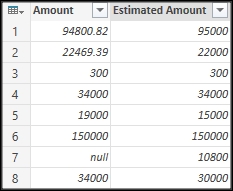The good thing about the Dynamics CRM is that it already has the correct formats you need for amounts and dates because of the data structure of this application. In Chapter 3, Building Summaries and Custom Calculations, you will be able to build sales summaries with the newly created datasets by pivoting and grouping the data. There may be a case where we need to format the dates or amounts while doing this.
Here is an example of how to format amounts:
-
In Power BI, select the OpportunitySet dataset from the left-hand side of the query window
 .
.
For the EstimatedAmount or ActualAmount column, click on the icon with the EstimatedAmount or ActualAmount header name and reset the column data type to value by unchecking and then rechecking the box.
Highlight the EstimatedAmount or ActualAmount column and change the Data Type to Decimal Number in the home ribbon:

Once the column values are changed to decimal, the column data types will be updated to decimal amounts:

Here...



